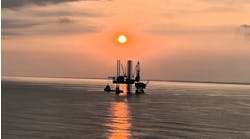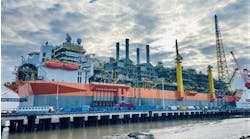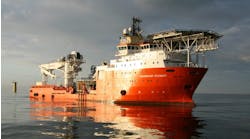Statoil finds oil on M
Statoil's latest exploration effort in the Norwegian Sea has confounded expectations. The well on the 'M' structure, drilled by the semisubmersible Scarabeo V, found oil in what had been assumed was a gas-condensate province. Production tests recovered light oil from two zones in Jurassic sandstone, one of which flowed 3,400 b/d through a 28/64-in. choke. 'M' lies 10 km north of Kristin, expected to form the hub for a multi-field, high pressure, high temperature development known as the Halten Bank South project.
In the same region, Norsk Hydro also hit the target with its Colette exploratory well, west of the Midgard Field. But the gas-condensate quantities yielded were sub-commercial. The semisubmersible Transocean Arctic then moved north to drill a dry hole for Hydro on the Blaaveis prospect - thereby failing to prove an extension of the giant Ormen Lange gas accumulation to the north.
The rig has since shifted farther north for a well on the Castor prospect, in waters previously barred to drilling, off the Lofoten Islands. This is an important fishing area, and also a nesting site for sea birds. The well was sanctioned on condition that synthetic and oil-based fluids would not be used. Hydro was also ordered to speed up its emergency response procedures in this location.
Uncertainty over LNG project
Development of Snohvit and other gas fields in the Barents Sea remains in the balance, despite conciliatory noises from Norway's Finance Ministry. Statoil and its partners had abruptly suspended planning operations following an impasse with the government over taxes and tariffs relating to the onshore facilities. These would include Norway's first LNG conversion plant, based near Hammerfest. Statoil had hoped to issue a production-development order for a NKr 40 billion development this summer, leading to first gas by late 2005. However, the deadlock on tariffs was hampering negotiations with potential buyers, also being courted by LNG consortia in North Africa and West Africa. The Finance Ministry has since requested further discussions with the Snohvit licensees, possibly mindful of the impact on local employment with general elections approaching.
Statoil has managed to secure sanction for a plan to increase gas exports from Gullfaks in the North Sea. Kvaerner has been awarded a $40 million contract to upgrade the Gullfaks A platform - it's doing a similar job currently for Statoil on Sleipner. In the Norwegian Sea, Norske Shell and its partners have approved a $77 million scheme to tie the 5.6 million cu meter Rogn South oil accumulation back to Draugen, via the Garn West subsea manifold. Recently, Shell increased its estimate of Draugen's productive life by five years, to 2016. Recoverable reserves in the area are now put at 726 million bbl, double the original estimate in 1984. The recovery rate has also risen to 67%, one of the highest anywhere on the Norwegian shelf.
Creativity needed to unlock UK reserves
UK North Sea activity is not in terminal decline, according to the sector's leading independent Talisman Energy. Speaking at an offshore operators briefing in Aberdeen last month, the company's UK manager Paul Blakeley said that the sector had yielded 26 billion bbl to date, with potential for a further 56 billion bbl, "if we get things right." For that to happen, he added, "we have to move away quickly from the behavior associated with major projects and billion bbl fields ellipse to a more pragmatic approach hallmarked by entrepreneurism, both technical and commercial, and a culture of openness and cooperation."
Blakeley clearly had in mind companies such as his own, which helped sustain the sector during the oil price crash through acquisitions and field rehabilitation programs. "At Talisman, we regard ourselves as much more than a mature field operator. Finding commercial solutions and building a significant acreage position around existing infrastructure is only the springboard to multiple lines of new investment. These range from facility upgrades and infill drilling, to satellite development and exploration programs ellipse However, to effectively unlock all the remaining potential in the North Sea, players with many different strategies are required, because only a diversity in approach will yield the maximum success."
Multinationals with an indulgent approach to profits would also help. Recent reports suggested that the UK government is considering another windfall tax on oil company profits in next year's budget, following customary outrage from pressure groups over BP and Shell's recent strong results. These activists probably missed the comment in the 'extremist' Daily Telegraph that while the government creams 80% of each 78p liter of gasoline in taxes, the cost of refining, transportation and retailing in Britain is 6p/liter - Europe's cheapest. So who is profiting?
Goldeneye, Juno moving forward
Shell seems to be pushing for an unmanned wellhead platform with full wellstream transfer for its planned Goldeneye gas-condensate development in the Outer Moray Firth. The facilities could also handle production from BP's Atlantic and Amerada Hess' Cromarty discoveries. In the southern North Sea, BG has invited tenders for a 600-ton platform for its Minerva Field, forming the hub of the new multi-field Juno project. BP aims to exploit its Maclure oil and gas discovery in the northern North Sea as a subsea tieback to Kerr-McGee's Gryphon A floater. Kerr-McGee has subsea plans of its own for a smaller accumulation called Gryphon South.
These modest announcements came too late to save the UIE Clydebank fabrication yard west of Glasgow, which has remained idle for two and a half years since completing outfitting on Talisman's Ross Field FPSO (recently re-outfitted to handle production from BG's Blake). The site has been put on the market, and will likely be converted into a new residential, leisure, and business complex. UIE was the last remaining offshore sector yard on Scotland's west coast, and the second casualty this year following closure of McDermott's facility in Ardersier in the north.
Rose blooms for BG
Smaller yards in England are more likely to benefit from the recent upsurge in exploration in the southern North Sea. BG Group announced that its Rose R2 well proved up gas in the Leman sandstone play fairway, 8 km north of the BG-operated Amethyst Field. The well flowed 30 MMcf/d and 90 b/d of condensate on test. It follows the Rose East discovery in the same block in 1998.
In the Dutch sector, NAM issued a rare statement concerning a new discovery in Rotliegendes sandstone in block K15. Preliminary tests revealed a 200-meter-long gas column, with reserves estimated at 11 bcm. If proven, this would represent one of the largest finds over the past 20 years on the Dutch CS. Wintershall's A15 block discovery is also rumored to be large - the operator recently started its appraisal campaign.




